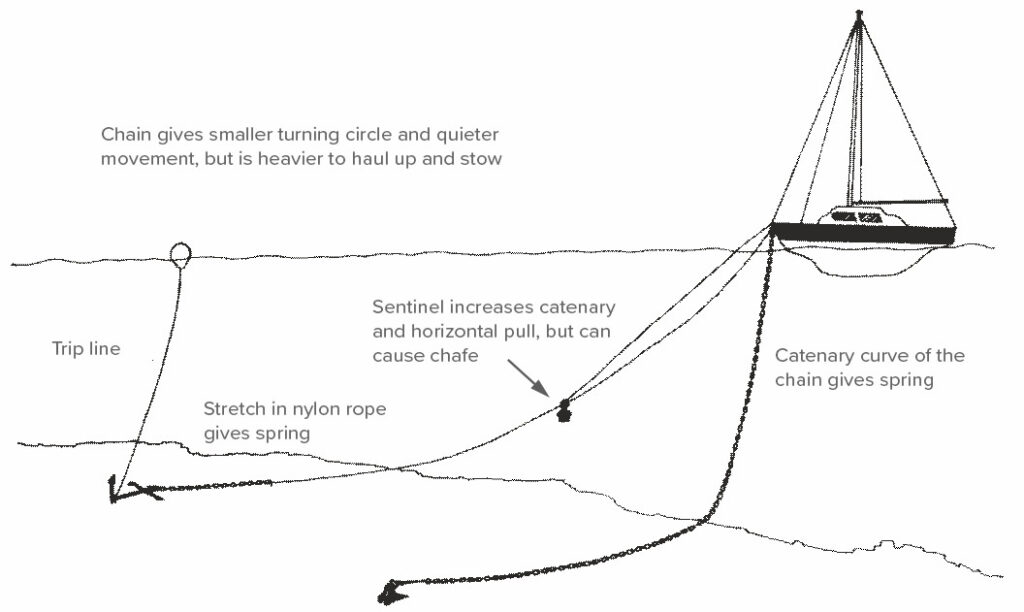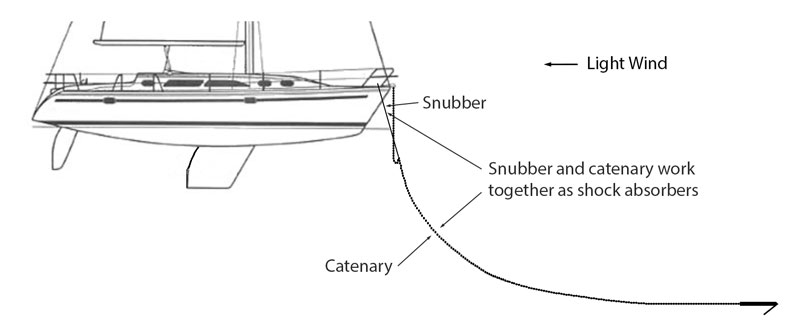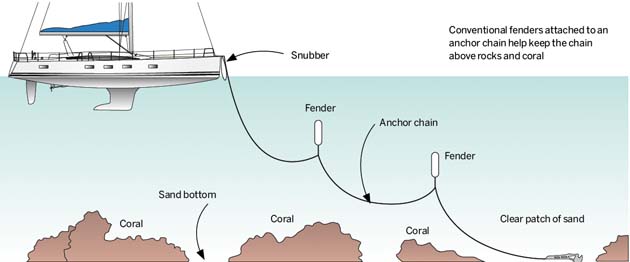Anchoring!
It’s a Spectator Sport like no other, it’s free and it’s happening in any busy bay near you or Tropical Anchorage from about 3:00pm every day. That’s right it’s the “Anchoring Dance.”
There are many variations on the dance from; the, Rock up and drop, deposit the contents of the anchor locker on the bottom and retire immediately to the cockpit for that first beer. To the, round and round in circles approach, (We see Cats do this, both feline and fibreglass) where they look for the perfect spot only to drop it right on top of your anchor, then when they get too close, casually advise you, in a knowing way, that you must have dragged. Then there’s the, let’s let the whole neighbourhood know we’re here technique, usually accompanied by a constant barrage of abuse directed at whoever is on the helm and other antics like jumping up and down on the foredeck with a face the colour of puce. And last but not least the Who needs Scope, the chap that has a great chain counter and thinks that a one to one scope is all you need.
The consequence is total bedlam when the wind gets up at 2:00 am the next morning and things go bump in the night.
The problem is who teaches you the art? If you’re new to the cruising game and don’t get a basic grounding before you go out you are likely to receive an education the hard way and that’s no fun at all.
I remember helping one poor chap get an education one year. I will admit that my teaching technique has improved since then.
It all started late one afternoon. This particular anchorage was, as usual, crowded and there was a bit of wind forecast. With the direction forecast we decided to anchor Windflower for the night along with every other man Jack and his dog. Now this anchorage is quite deep, especially if you’re not first in. We nosed into a good spot, let out a good 5 to 1 scope, remember it’s going to get windy, pulled back and gave it some revs to set the anchor. Satisfied we had a good hold we hopped in the dingy and hopped over to a friends boat, close by, for sundowners.
We were enjoying a beer and some entertainment on the back deck watching the constant stream of craft of all shapes and sizes coming into anchor, with varying degrees of success. The wind was already starting to pipe. One quite small cruiser had been experiencing some difficulty and had been messing around for some time, eventually pulling up just in front of Windflower. As he came out of the cockpit I remarked, “You’ve got to be kidding, he’s not going to drop it there, is he”? “Anchors away” was the response with a chuckle from my friend.
Over the next half hour our hapless cruiser slipped closer and closer to the bow of Windflower and we were taking a sweepstake on how long it would be before he bailed and tried again. He could have reached out and touched our bow before he reluctantly admitted defeat. We watched as he struggled to get his anchor up and eventually headed back the cockpit. “I don’t see his anchor” said Kevin. Out came the binoculars and sure enough all we could see on the bow as he motored off through the boats was his chain hanging down.
The next and most distressing thing we noticed was Windflower on the move. Putting out a 5 to 1 scope in a busy anchorage will give you a good hold but it also encourages the odd plonker to anchor over your pick. In this case the late comers anchor had fouled with ours and the reason he hadn’t got his anchor all the way up was because he was lifting ours as well. About that time he must have experienced a serious brain fart as there were several blatant indicators that all was not well. I do however give him full marks for persistence as he firewalled his motor to get some way on. Even one glance over his shoulder would have alerted him to the fact that his tender had miraculously expanded by a factor of thousands and was soliciting worried looks from boats in or near his path.
How we didn’t do some serious damage I’ll never know, 25 tons of rampaging, uncontrolled boat doesn’t bear thinking about. We left the girls to make frantic VHF calls while the boys dived into the dingy to give chase. We eventually caught up with our hapless idiot when he slowed down after hearing the mounting chorus of yells from other anchored boats. Out in the middle of the bay we spent half an hour untangling the two anchors by eventually pulling ours up from the bottom up and untying the knot on the fore deck of the smaller boat. Our “friend” then chucked our anchor back into the briny and proceeded back into the anchorage while we recovered our tackle, again.
On our return we were greeted by the sight of the little sod anchored in the place we had just been extracted from, the site where I now gave him an unabridged 5 minute lesson on anchoring and its associated ethics. He had his anchor up and was well out the bay before I came to a very red faced end to my dissertation and we re-anchored Windflower.
Now for the abridged version. So what are the rules.
1/. Pick a bay where you are going to get good shelter from the forecast wind, not necessarily the wind at the time.
2/. Have an escape plan, a course out of the bay and a secondary anchorage all plotted if it all turns to custard and you have to move at night.
3/. Get in early if the forecast isn’t good, last in first out and being at the back there is more likely hood of someone dragging down on you.
4/. Even if the bay is busy, find room to allow you plenty of scope and swing room.
5/. Don’t anchor directly in front of another boat, stagger your position by pulling up between two other boats and dropping your anchor parallel with their sterns.
6/. Reverse back as you pay out your chain or rode and set your anchor by backing it in slowly. Once you are sure you are set, give the engine some juice to make sure.
7/. If it’s windy don’t just set and forget. Keep an anchor watch, often times it will be someone else dragging down on you that you’re looking out for.
8/. If you are too close, when you settle, to another boat, don’t wait for the other guy to lose his rag at you, pick up and try again.
9/. Develop a series of hand signals. It’s hard to hear on the bow and there’s nothing worse than hearing people scream at each other.
10/. Always allow yourself enough swing room if the wind does a 180.
What is Scope?
No anchor will work if it is hanging straight down, it’s simple physics. As load comes on your anchor from the boat being pushed back, wind, tide etc. the chain or rope will stretch out and lift off the bottom. If there is too great an angle as it comes tight it will pluck the anchor out and you’ll start dragging. To decrease the angle and give better holding you need to increase the scope by letting more chain/ rope out.

We work usually to a 5 to 1 scope. Take the depth of the water (from your depth sounder, adjusted to the surface) add the height to high tide then add the height your bow is off the water to the anchor roller. Eg. You are in 3m of depth, plus 2m to high tide plus 2m to the bow roller = 7m total x 5 = Let 35m of chain out. Then start backing the anchor in (slowly) until you have a good hold.
There’s an old expression, “if it’s in your anchor locker it’s not helping”.
Setting the anchor.
Once you’ve backed up slowly and you feel the anchor has set, leave the motor running in reverse, pick a spot on the land at right angles to the boat and line it up using an object closer to you. If the background is moving relative to the object in the foreground then the anchor isn’t set. If the background is stationary then start adding revs’ keeping an eye on your markers, about 20 seconds is enough at half cruising revs to give you a good set.
Types of Bottom.
Check the cruising guide to find out what type of bottom is in the bay, ie. sand, mud, shingle, rock and if there is a likely hood of weed or other factors that will impede your anchor from setting. Sand and mud will generally give you a good hold but if there is weed then getting through it can be challenging. Shingle has less holding power so allow more scope, up to 8 to 1 and in rock it is often a good idea to attach a retrieval line to the front of the anchor to “trip” it if it gets fouled.
Tricks for poor holding.
Sometimes no matter how much scope you put out the holding is just not there. Try adding another smaller anchor in series (see insert). Attach about 3 meters of chain to the front of your main anchor and attach another smaller anchor to this, usually a small Danforth. This tandem anchor will increase holding exponentially.
What is Cantenary?
Catenary is the curve that hanging chain or cable assumes when supported at its ends and acted on only by its own weight. Catenary helps to keep the pull on the anchor at a flatter angle so weight in your chain or rope is good, it also acts as a shock absorber. If you are in an anchorage where there is little room you can create the same effect by adding a weight or “Kellett” to the line. An “Anchor Buddy” is a good example.

Anchor Strop/Snubber.
Take the strain off your anchor windlass. If you are using chain and rope, tie off to a Sampson Post or Cleat. If you use all chain get yourself a “Snubber”. (see photo) A length of Nylon or Polyprop line with a chain hook on one end. Hook the chain and pay out about 3m of line before cleating off. Pull out some chain to allow for stretch and make fast your windlass. The idea behind a snubber is not only to take the shock load off the windlass but to allow some shock absorbing effect on the anchor and chain.
Lights and Day Shapes.
At anchor the proper Day shapes and lights should always be flown to alert other vessels you are at anchor. During the Day; a round black ball, flown in the fore triangle. At night, a white light under the ball, visible 360 degrees. Under the collision regs if you’re not showing these you are deemed to be under way, a subsequent collision may render you at fault.
Hand Signals.
Approach your desired anchoring spot slowly and use the following to direct the helms person from the bow.
Left and right. Hand held out flat at arms length. To increase the speed of turn rotate palm flat facing up and curl fingers up and down. Rotate palm down to slow rate of turn. As the bow comes onto desired line move your arm in line with heading.
Speed up, slow down. Hand pointing up with one finger rotating to increase speed same pointing to the deck to slow down.
All Stop:- Arm bent at elbow with clenched fist.
Make sure you are visible to the helms person, if necessary step across the foredeck for better visibility. Never point at something of interest, like a rock or similar, the helm is likely to take it as a command to go that way, ouch!
Have some fun and develop other signals to help your individual needs.
And Then There’s Anchoring in Coral!
You can do significant damage to coral if you allow your Chain to Drag across it. The beauty of most tropical anchorages is that the water is clear and you can generally pick a spot over sand to do your initial drop.
You’ll still need to use the same calculation for scope as above but you can create a False Bottom by Buoying your chain and lifting it above the coral. See Diagram Have some fun and develop other signals to help your individual needs.

Author – John Martin – Revised April 2023
